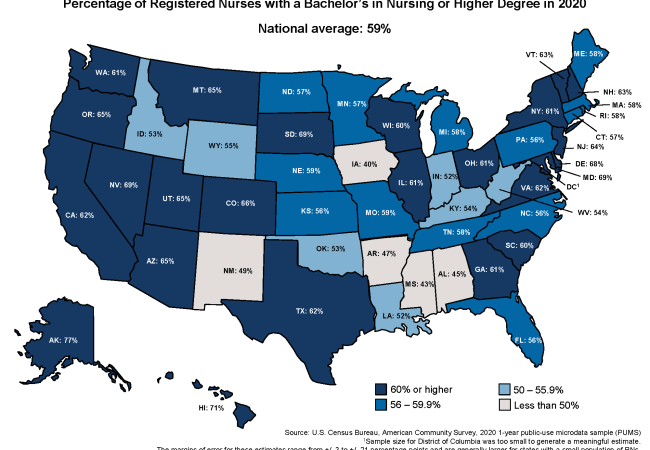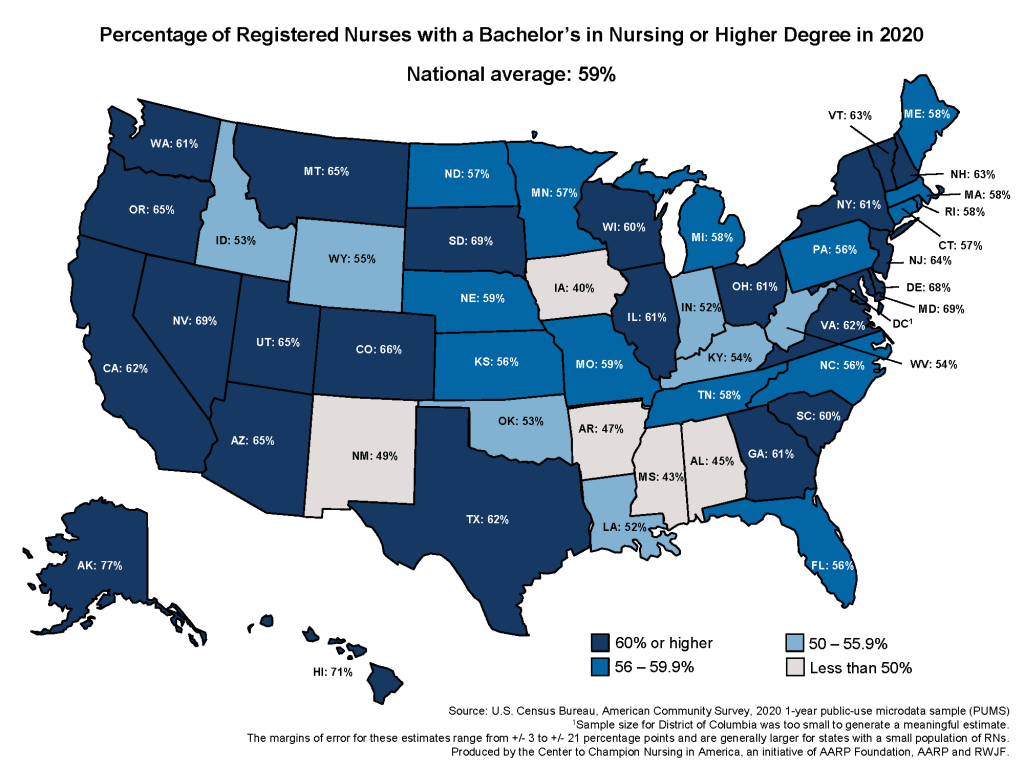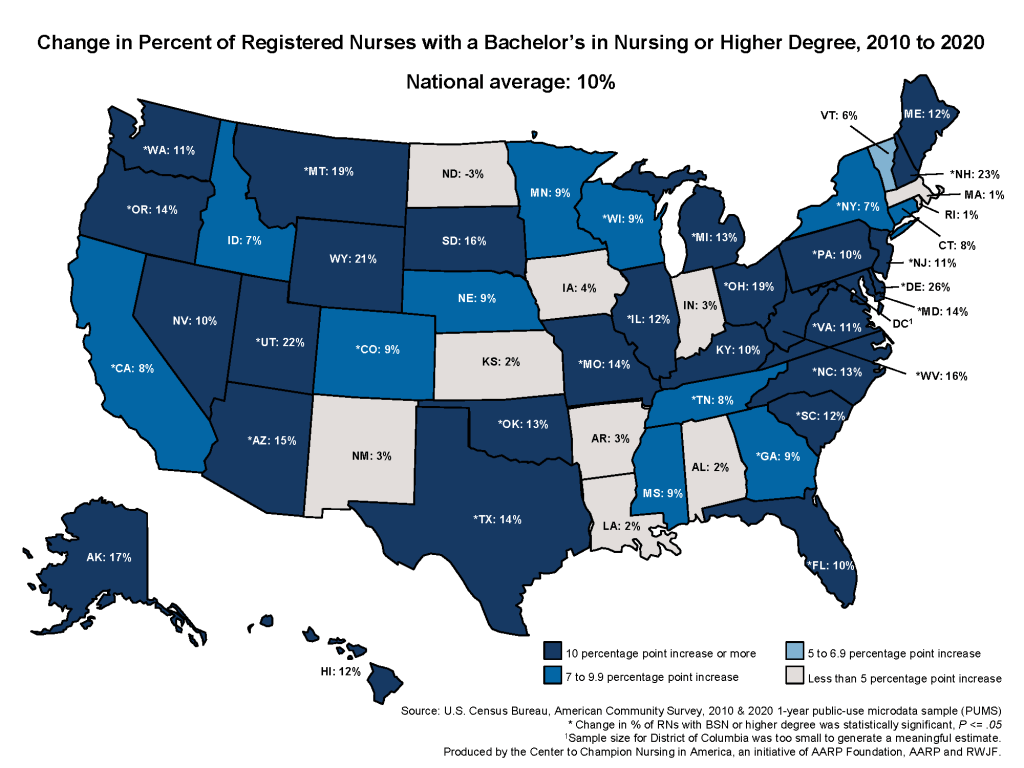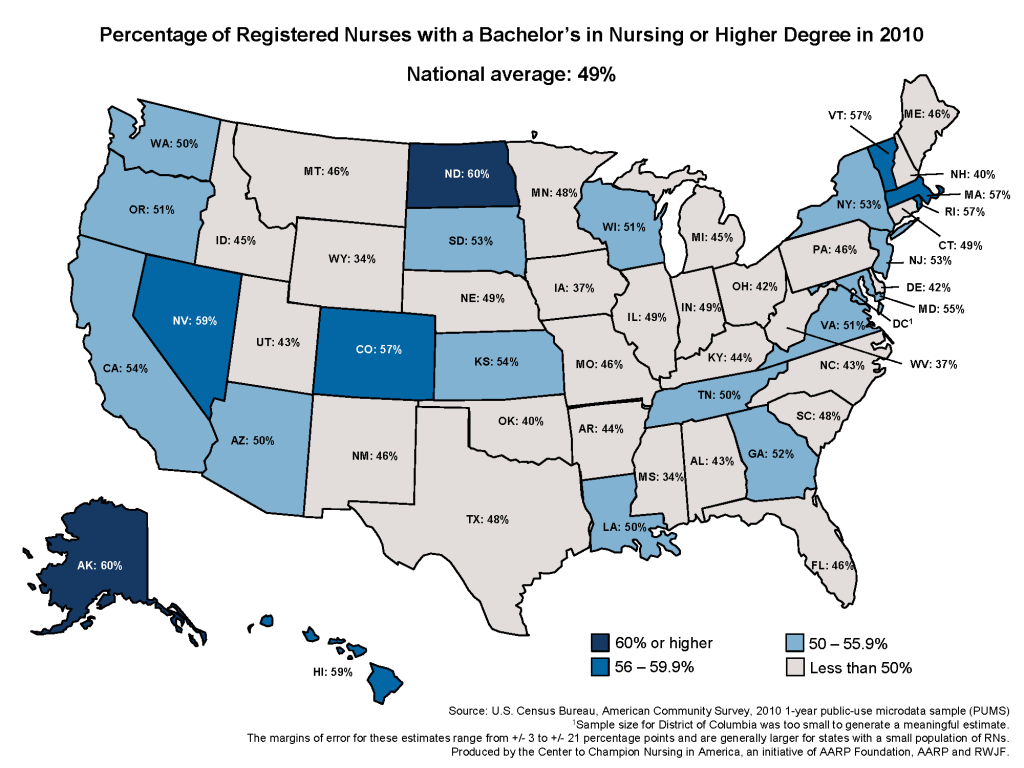
Mar 22, 2023
Maps Illustrate a Decade of Progress in Nursing Education

From its earliest days, the Future of Nursing: Campaign for Action, an initiative of AARP Foundation, AARP and the Robert Wood Johnson Foundation, has worked to implement recommendations in the 2010 Institute of Medicine report, The Future of Nursing: Leading Change, Advancing Health.
One of its top recommendations was increasing the proportion of registered nurses (RNs) with a baccalaureate in nursing (BSN) to 80 percent by 2020, for several reasons. A more highly educated nursing workforce is needed to care for diverse patients with complex needs, to promote health equity and reduce disparities, to adapt continually to new technologies, and to lead and collaborate with other health professionals and community partners. Highly educated nurses are needed to bring health care to communities that don’t have access to it, and to prepare for disasters and respond to public health emergencies, such as COVID-19. Both the first future of nursing report, and the second, the Future of Nursing 2020-2030: Charting a Path to Achieve Health Equity, describe how patient outcomes markedly improve as the percentage of baccalaureate and higher educated nurses increase.
In addition to advancing the recommendations, the Campaign has also been tracking their progress on its Dashboard, including number of BSN nurses. The progress has been impressive, even as it fell short of the goal: the percentage of RNs with a BSN or higher was just 49 percent in 2008, increasing to 59 percent by 2020.
The Campaign is sunsetting this particular metric from its Dashboard this year as the focus shifts to achieving health equity through nursing. Susan Reinhard RN, PhD, FAAN, senior vice president and director, AARP Public Policy Institute and chief strategist of the Center to Champion Nursing in America (CCNA), which runs the Campaign, reflected on the transition. “We have witnessed significant changes over the course of my career in nursing, and it seems to have accelerated in the last decade, thanks in part to the Campaign for Action. Seeing a large majority of RNs now working with a bachelor’s degree or higher is one change we can all celebrate.” The transition toward nurses leading in health equity includes a greater focus on, and more resources devoted to, the role of nurses in tackling health disparities. “And with that extra education,” Reinhard continued, “comes a greater ability to assume more responsibility in making decisions, taking on leadership roles and, importantly, understanding the social determinants of health and tackling health inequities.”
What follows is a look back at the significant progress that has been made towards bringing more highly educated, highly skilled nurses into the workforce.

The data sources we have used to account for the increasing percentage of baccalaureate and higher RNs are the educational preparation of first time RN licensure (NCLEX) exam takers with baccalaureate degrees, and the number of RN-to-BSN and RN-to-Master of Science in nursing (MSN) graduates.

The number of graduates of RN-to-BSN programs has also grown significantly in the last decade, as noted in the Campaign for Action dashboard graph.
Every year new RNs with baccalaureate and higher degrees enter the workforce and experienced RNs graduate with BSN and higher degrees, resulting in a more highly educated nursing workforce. Another factor that increases the overall education level of nurses, is the number of RNs who retire each year. These retiring RNs may have been educated in a diploma program or in an associate degree program, and did not advance their education before they retired. The net effect of these lesser educated retirees leaving the profession is a net increase in RN education.
As the Campaign for Action sunsets this data measure, it is important to credit the educational progression models and funded programs that contributed to the significant progress towards a more highly educated nursing workforce. The 2017 compendium, Nursing Education and the Decade of Change: Strategies to Meet America’s Health Needs, credits the RWJF Academic Progression in Nursing (APIN) program, the RWJF Future of Nursing State Implementation Program (SIP), and AARP’s Center to Champion Nursing in America, all initiatives of RWJF.
“RWJF’s Academic Progression in Nursing (APIN) program and its State Implementation Program (SIP) were catalysts for the change we’ve seen in nursing education. That work helped to remove obstacles that slowed nurses in obtaining their BSNs,” said Ashley Darcy-Mahoney PhD, NNP-BC, FAAN, RWJF senior nurse scholar and professor at The George Washington University School of Nursing.
APIN was the continuation of an intensive push by RWJF to identify and support successful efforts to increase the number of nurses with bachelor’s degrees in nursing. The nine state-based Campaign for Action Action Coalitions in the APIN program implemented the shared curriculum model, meaning nursing programs in universities accepted coursework from community colleges or allowed dual enrollment. Both of these strategies resulted in more BSN graduates. Darcy Mahoney notes that in the end, this is all about the communities those BSNs can serve. “And since nurses are the largest segment of the health care workforce, this sea change in attitudes and actions affects every American as health needs grow and technology becomes more complex.”
SIP awarded grants to 21 of the Campaign’s state Action Coalitions, which allowed them to try various approaches to increase the number of RNs with a BSN degree in their states, as well as increase diversity in nursing. SIP recipients created marketing and communication strategies, streamlined nursing curricula, and fostered education and employer partnerships. SIP recipients created more than 100 resources available on the Campaign for Action website and help to advance nursing education throughout the nation.
The three maps detail how the percentage of registered nurses with a bachelor’s in nursing or higher degree increased from 49 percent in 2010 to 59 percent in 2020. “Advancing the health of patients, families and communities depends on increasing levels of nursing education,” said Antonia M. Villarruel PhD, RN, FAAN, Professor and the Margaret Bond Simon Dean of Nursing University of Pennsylvania School of Nursing and chair of the Campaign for Action Strategic Advisory Committee. “Nursing schools — at all levels, nursing organizations and state governments have been working together for years to make it easier for aspiring nurses to get a bachelor’s degree and it’s finally paying off.”


Although the goal of 80 percent by the year 2020 was not met, significant progress has been made. The APIN and SIP programs have well positioned states to continue toward a more highly educated nursing workforce.
Andrea Brassard, a former strategic policy advisor at the Center to Champion Nursing in America, is an associate professor at the University of Maryland School of Nursing.
